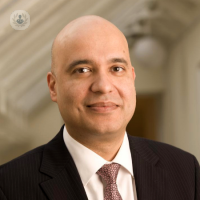Tracheostomy: why is it used?
Escrito por:There are a number of reasons where having a tracheostomy fitted may be necessary, but the great news is that it is possible to enjoy a good quality of life with one. It may, however, take a little time to adapt to talking and eating.
We’ve asked leading otolaryngologist and ENT surgeon Mr Guri Sandhu how a tracheostomy works and under what circumstances it would be required.

What is a tracheostomy?
A tracheostomy is a surgical intervention where a hole is made in the front of the neck and into the wind pipe. It is kept open with a tube that is called a tracheostomy tube. Usually, there are ribbons around the neck that keeps this tracheostomy tube in place.
When is a tracheostomy necessary?
The reasons for a tracheostomy are most commonly to manage an obstruction of the airway. You may be born with a narrowing of your windpipe and may not be able to breathe easily so a tracheostomy is placed. Sometimes there is a tumour occurring in the larynx, which is your tongue base, that is restricting your airway.
Sometimes there is a serious infection, such as a very bad case of laryngopharyngitis. This may cause narrowing of your windpipe and you might need a tracheostomy temporarily.
Other reasons for tracheostomies are to support your ventilation. Imagine you have a really serious lung disease or your lungs are damaged. Or you have a neurological condition that has weakened the muscles for breathing. A tracheostomy is then placed to support your ventilation.
Sometimes, we will put a tracheostomy in intensive care unit patients who are not progressing rapidly to waking up. Putting a tracheostomy in then allows the drugs that are keeping the patient asleep to be reduced so that they are more aware and they can even communicate. In some cases, they may even start to feed.
Book an appointment with Mr Sandhu if you need advice on any of your ear, nose or throat conditions at the Harley ENT Practice in London.


